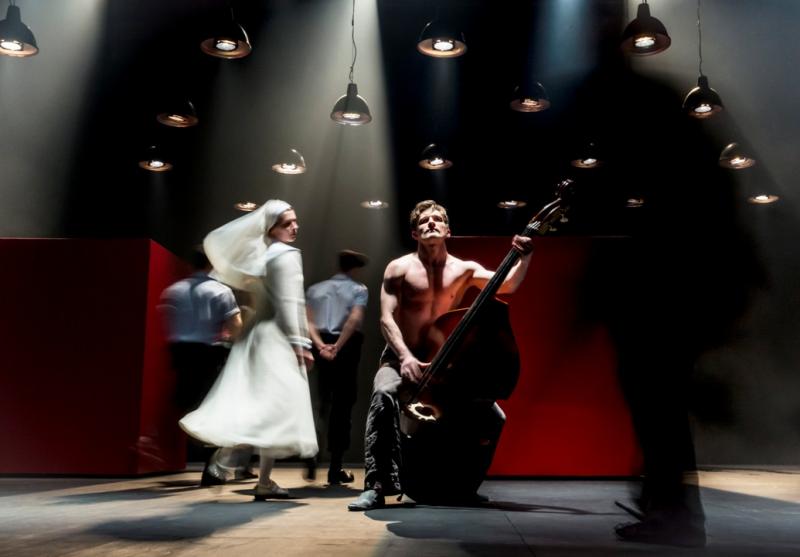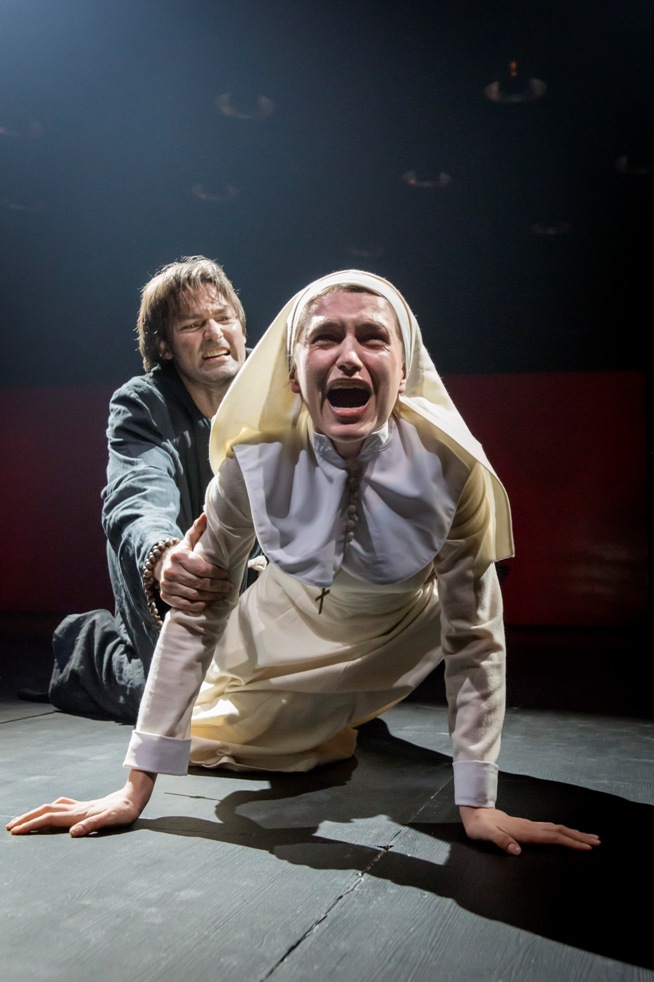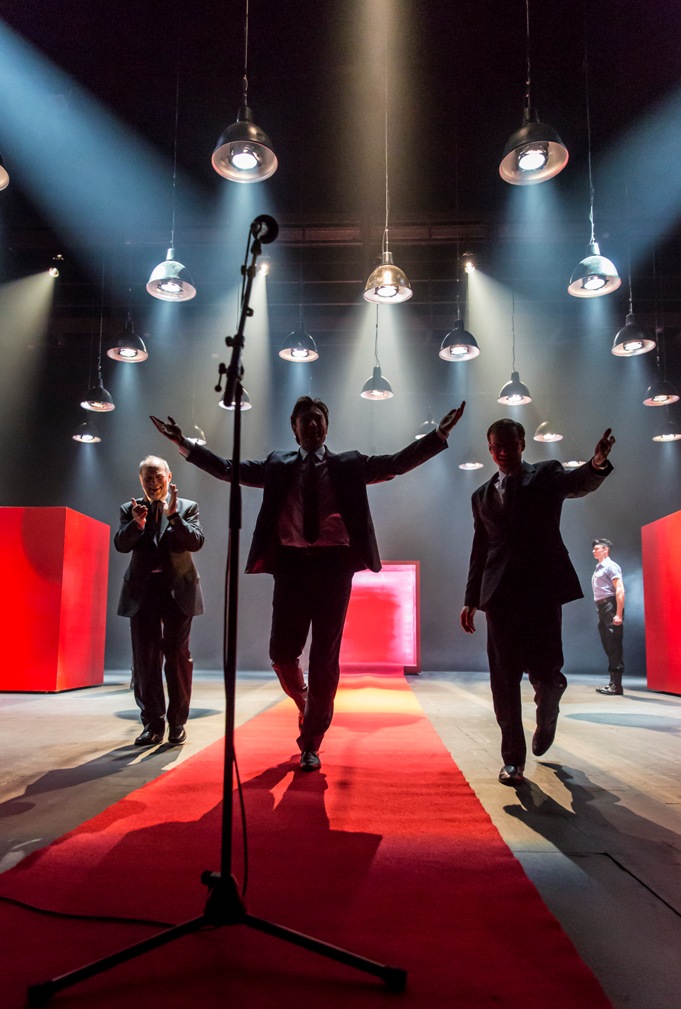Measure for Measure, Cheek by Jowl/Pushkin Theatre, Barbican | reviews, news & interviews
Measure for Measure, Cheek by Jowl/Pushkin Theatre, Barbican
Measure for Measure, Cheek by Jowl/Pushkin Theatre, Barbican
Stark exposition, explosive consequences in strangest Russian Shakespeare

Russia isn’t the only country where violations of personal freedoms and censorship seem to be mounting by the day, but it’s surely the most confused: ask any of the persecutors what they hope to achieve, and you won’t get a convincing answer.
Most home-grown productions I’ve seen have tried to be too ingratiating, getting easy laughs from the improvised game-playing of the “fantastical duke of dark corners” who absents himself only to don a monkish disguise in an attempt to get a grip on his city’s perceived decadence and see how his stern deputy cracks down on it. In this production, the more he tries to shine a light on human behaviour, the more nightmarish his journey becomes. The greater the clarity of the opening scenes, the more terrifying and murky the descent into the abyss.
 Cheek by Jowl’s disconcerting mixture of clean lines, ambiguity and terror pays off by degrees. This is the polar opposite of the Vakhtangov Theatre’s approach in the last Russian visit to the Barbican. Some liked its chuck-everything-at-it approach, the obscurity of its multiple references, the constant use of music in that company’s Eugene Onegin; I hated their Uncle Vanya. Anyway, the focus on the text, the absence of all but street noises and the occasional electronic terror until the mid-point here are hugely refreshing. All we have on stage at the start are five giant red boxes, overhead lamps - Sergey Skornetskiy's lighting design as realised by Pavel Bolotin is subtle but extraordinary, especially when we first see novice Isabella at prayer - and the entire company, the pack stalking the presumably paranoid Duke before he takes his leave.
Cheek by Jowl’s disconcerting mixture of clean lines, ambiguity and terror pays off by degrees. This is the polar opposite of the Vakhtangov Theatre’s approach in the last Russian visit to the Barbican. Some liked its chuck-everything-at-it approach, the obscurity of its multiple references, the constant use of music in that company’s Eugene Onegin; I hated their Uncle Vanya. Anyway, the focus on the text, the absence of all but street noises and the occasional electronic terror until the mid-point here are hugely refreshing. All we have on stage at the start are five giant red boxes, overhead lamps - Sergey Skornetskiy's lighting design as realised by Pavel Bolotin is subtle but extraordinary, especially when we first see novice Isabella at prayer - and the entire company, the pack stalking the presumably paranoid Duke before he takes his leave.
It’s hard work for the audience at first. This is one of Shakespeare’s most rhetorical plays, full of dense thought and microscopic examination of mixed motives. One’s biggest hope is that the actors will have been directed to clarify the ideas through their mode of speech, but here you have to cope with fairly swift Russian delivery and the original text in the supertitles. But you won’t miss the rapid trajectory in which each of the characters implodes. Anna Khalilulina’s Isabella (pictured above with Alexander Arsentyev's Duke), pleading for a brother whose only crime has been to make his girlfriend pregnant, breaks her fear and reserve in front of seemingly impassive deputy Angelo (Andrei Kuzichev) in sudden feet-kissing and physical pleas which partly account for his lustful attraction to supposed purity.
 These two are compelling, Khalilulina especially in that you can read every emotion in her face and body language, making us identify with her predicament. In comparison, Alexander Arsentyev’s Duke is rather too low-key: many of his edgy confidences don’t carry even in a relatively small arena like the Silk Street Theatre (the Guildhall’s rather sterile larger performing space). But he’s certainly a man of multiple personalities, and his uncertain machinations explode in a riot of movement and music. Pavel Akimkin’s score, when it bursts into colour, proves well worth the wait.
These two are compelling, Khalilulina especially in that you can read every emotion in her face and body language, making us identify with her predicament. In comparison, Alexander Arsentyev’s Duke is rather too low-key: many of his edgy confidences don’t carry even in a relatively small arena like the Silk Street Theatre (the Guildhall’s rather sterile larger performing space). But he’s certainly a man of multiple personalities, and his uncertain machinations explode in a riot of movement and music. Pavel Akimkin’s score, when it bursts into colour, proves well worth the wait.
Of course it helps to have a former male model who also happens to be a good actor, Petr Rykov, stripped to the waist and playing a double-bass line over which a waltz unfolds as a dance of death, the rest of the cast leading each other into the depths of the plot just when you'd expect an interval (this Measure for Measure is the first I've seen to run without one). Mariana at the moated grange, the jilted lover who’ll replace Isabella in the bed of the obsessed Angelo, whizzes into action, sings the famous “Take, o take those lips away” and disappears until the final scene (pictured above).
That scene is played for all it’s worth, at length. Demagoguery yields to violent repression; the Duke’s puppeteering turns nasty; Isabella – already discombobulated by a second sexual assault she and we didn’t expect, from her own brother – seems on the brink of ultimate breakdown; things fall apart. The centre barely holds when Claudio is revealed to be alive.
It’s a test of directorial intelligence whether Isabella’s recognition of her brother will be silent – as it was for a whole minute when Juliet Stevenson played the role at the RSC – or filled with crass music (Trevor Nunn’s sickly Viennese waltz at the Young Vic). The fact that, having been brought to her knees to plead for mercy, rejecting measure for measure, she speaks not one word to the end of the play seemed so radical here that I had to go back to the text and check that nothing had been cut. Clever Shakespeare! No word of greeting, nothing, a clean slate for the director to work on, a licence for bleakness and disorientation. Ormerod and Donnellan have been here before, with their UK Cheek by Jowl company, already a stark and impressive production. But this one hits new, uncompromising heights of a kind we rarely see on the British stage
- Measure for Measure at the Barbican's Silk Street Theatre until 25 April, then at the Oxford Playhouse, 28 April - 2 May
rating
Buy
Explore topics
Share this article
Add comment
The future of Arts Journalism
You can stop theartsdesk.com closing!
We urgently need financing to survive. Our fundraising drive has thus far raised £33,000 but we need to reach £100,000 or we will be forced to close. Please contribute here: https://gofund.me/c3f6033d
And if you can forward this information to anyone who might assist, we’d be grateful.

Subscribe to theartsdesk.com
Thank you for continuing to read our work on theartsdesk.com. For unlimited access to every article in its entirety, including our archive of more than 15,000 pieces, we're asking for £5 per month or £40 per year. We feel it's a very good deal, and hope you do too.
To take a subscription now simply click here.
And if you're looking for that extra gift for a friend or family member, why not treat them to a theartsdesk.com gift subscription?
more Theatre
 Ghosts, Lyric Hammersmith Theatre - turns out, they do fuck you up
Ten years on, Gary Owen and Rachel O'Riordan top their triumphant Iphigenia in Splott
Ghosts, Lyric Hammersmith Theatre - turns out, they do fuck you up
Ten years on, Gary Owen and Rachel O'Riordan top their triumphant Iphigenia in Splott
 All the Happy Things, Soho Theatre review - deep feelings, but little drama
New play about a sibling’s death is well imagined and deeply felt, but a bit slender
All the Happy Things, Soho Theatre review - deep feelings, but little drama
New play about a sibling’s death is well imagined and deeply felt, but a bit slender
 Shanghai Dolls, Kiln Theatre review - fascinating slice of history inadequately told
Amy Ng's take on two Chinese titans needs more dramatic ballast
Shanghai Dolls, Kiln Theatre review - fascinating slice of history inadequately told
Amy Ng's take on two Chinese titans needs more dramatic ballast
 Manhunt, Royal Court review - terrifyingly toxic masculinity
After his Olivier Award win for Oedipus, Robert Icke turns to a modern “monster”
Manhunt, Royal Court review - terrifyingly toxic masculinity
After his Olivier Award win for Oedipus, Robert Icke turns to a modern “monster”
 Midnight Cowboy, Southwark Playhouse - new musical cannot escape the movie's long shadow
Two misfits misfire in misconceived show
Midnight Cowboy, Southwark Playhouse - new musical cannot escape the movie's long shadow
Two misfits misfire in misconceived show
 Thanks for Having Me, Riverside Studios review - snappily performed comedy with a lightweight core
Writer-actor Keelan Kember floods the stage with a torrent of gags but few ideas
Thanks for Having Me, Riverside Studios review - snappily performed comedy with a lightweight core
Writer-actor Keelan Kember floods the stage with a torrent of gags but few ideas
 Rhinoceros, Almeida Theatre review - joyously absurd and absurdly joyful
Ionesco classic gets an entertainingly vivid and contemporary update
Rhinoceros, Almeida Theatre review - joyously absurd and absurdly joyful
Ionesco classic gets an entertainingly vivid and contemporary update
 The Importance of Being Oscar, Jermyn Street Theatre review - Wilde, still burning bright
Alastair Whatley honours his subject in a quietly powerful performance
The Importance of Being Oscar, Jermyn Street Theatre review - Wilde, still burning bright
Alastair Whatley honours his subject in a quietly powerful performance
 Stiletto, Charing Cross Theatre review - new musical excess
Quirky, operatic show won't please everyone, but will delight many
Stiletto, Charing Cross Theatre review - new musical excess
Quirky, operatic show won't please everyone, but will delight many
 Alfred Hitchcock Presents: The Musical, Theatre Royal Bath review - not a screaming success
1950s America feels a lot like 2020s America in this portmanteau show
Alfred Hitchcock Presents: The Musical, Theatre Royal Bath review - not a screaming success
1950s America feels a lot like 2020s America in this portmanteau show
 Wilko: Love and Death and Rock'n'Roll, Southwark Playhouse review - charismatic reincarnation of a rock legend
Johnson Willis captures the anarchic energy and wit of the late guitarist
Wilko: Love and Death and Rock'n'Roll, Southwark Playhouse review - charismatic reincarnation of a rock legend
Johnson Willis captures the anarchic energy and wit of the late guitarist

Comments
Agree largely with this
The text occurs at the
The text occurs at the beginning of Act IV Scene i, so do you mean the tune they used for it in this production? The earliest one we have is by John Wilson, dated 1625, but it wasn't that. Maybe someone else can provide the answer.